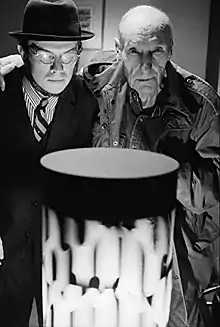Dreamachine
The Dreamachine (a contraction of Dream Machine) is a stroboscopic flicker device that produces visual stimuli. Artist Brion Gysin and William S. Burroughs' "systems adviser" Ian Sommerville created the Dreamachine after reading William Grey Walter's book, The Living Brain.[1]

History
In its original form, a Dreamachine is made from a cylinder with regularly spaced shapes cut out of its sides. That cylinder is then placed upon a record turntable and rotated, depending on the scale, at either 78 or 45 revolutions per minute. A light bulb is suspended in the center of the cylinder with the rotation speed making light emanate from the holes at a consistently pulsating frequency range of 8 – 13 flickers per second. It is meant to be looked at through closed eyelids, upon which moving yantra-like mandala visual patterns emerge, and an alpha wave mental state is induced. The frequency of the pulsations correspond to the electrical oscillations normally present in the human brain while relaxing. In 1996, the Los Angeles Times deemed David Woodard's iteration of the Dreamachine "the most interesting object" in Burroughs' major visual retrospective Ports of Entry at LACMA.[2][3] In a 2019 critical study, Beat scholar Raj Chandarlapaty revisits and examines Woodard's “idea-shattering” approach to the near-forgotten Dreamachine.[4]:98–101
The Dreamachine is the subject of the National Film Board of Canada 2008 feature documentary film FLicKeR, by Nik Sheehan.[5]
Use
A Dreamachine is "viewed" with the eyes closed: the pulsating light stimulates the optic nerve and thus alters the brain's electrical oscillations. As users adjust to the experience, they see increasingly complex animated yantra-like patterns of color behind their closed eyelids (similar effects may be seen when travelling as a passenger in a car or bus; close your eyes as the vehicle passes through the flickering shadows cast by regularly spaced roadside trees, streetlights or tunnel striplights—these were the hypnagogic effects Brion Gysin said he sought to recreate with the device). It is claimed that by using a Dreamachine meditatively, users enter an alphawave, or hypnagogic state.[6] This experience may sometimes be quite intense, but to escape from it, one needs only to open one's eyes.[1] The Dreamachine may be dangerous for persons with photosensitive epilepsy or other nervous disorders. It is thought that one out of 10,000 adults will experience a seizure while viewing the device; about twice as many children will have a similar ill effect.[7]
See also
- Brainwave entrainment
- Jan E. Purkyně
- Mind machine
- Feraliminal Lycanthropizer (the opposite effect machine)
Notes
- Cecil, Paul (March 2000). "Everything is Permuted". Flickers of the Dreamachine. Retrieved 2007-03-27.
- Knight, C., "The Art of Randomness", Los Angeles Times, August 1, 1996.
- Bolles, D., "Dream Weaver", LA Weekly, July 26–August 1, 1996.
- Chandarlapaty, R., "Woodard and Renewed Intellectual Possibilities", in Seeing the Beat Generation (Jefferson, NC: McFarland & Company, 2019), pp. 98–101.
- Official film promo website.
- Kerekes, David (2003). Headpress 25: William Burroughs & the Flicker Machine. Headpress. p. 13. ISBN 1-900486-26-1.
- Allen, Mark (January 20, 2005). "Décor by Timothy Leary". The New York Times. Retrieved 2007-03-27.
References
- Cecil, Paul. (2000). Flickers of the Dreamachine. ISBN 1-899598-03-0 Download excerpts.
Further reading
- McKenzie, Andrew M. (1989). "The Hafler Trio & Thee Temple Ov Psychick Youth - Present Brion Gysin's Dreamachine". Belgium: KK records. Retrieved 2010-10-21.
- Cecil, Paul (1996). Flickers of the Dreamachine. ISBN 1-899598-03-0.
- Geiger, John (2003). The Chapel of Extreme Experience: A Short History of Stroboscopic Light and the Dream Machine. ISBN 1-932360-01-8. Archived from the original on 2005-04-08. Retrieved 2005-07-29.
- Vale, V (1982). Re-Search: William S. Burroughs, Brion Gysin, Throbbing Gristle. ISBN 0-940642-05-0. Archived from the original on 2008-05-19. Retrieved 2008-06-25.
- Gysin, Brion (1992). Dreamachine Plans. ISBN 1-871744-50-4. Archived from the original on 2006-09-09. Retrieved 2006-03-10.
External links
| Wikimedia Commons has media related to Dreamachine. |
| Wikiquote has quotations related to: Dreamachine |
- Dreamachine exhibition at Cabaret Voltaire (Zurich)
- Khoroshylova, O. A., "Demonstration unit" at Freud's Dreams Museum (in Russian), TimeOut St. Petersburg, Sept. 20, 2007.
- (in French) Interzone: Dreamachine - Machine à rêver
- Online Dreamachine application
- JavaScript Dreamachine
- Info on Dreamachine iOS and Android app
- An open-source mobile-friendly Dreamachine App
- Dreamachine Simulator on YouTube, using Gysin's original frequency and cut out specifications.